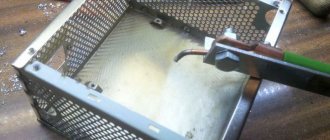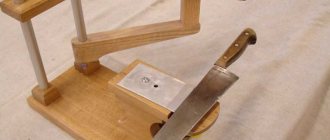It is not difficult to make spot welding for 18650 batteries with your own hands - it is reliable, which is why it is popular. This method ensures fixation of the material in individual places of the workpiece, allowing you to connect both miniature elements in electronic devices and heavy steel sheets.
Spot welding for batteries has found its active application.
Features and principle of operation of spot welding
Often, spot welding machines are made independently. Even if you purchase a device in a store, in order to obtain the desired characteristics, it will need to be modified, for example:
- increase the current;
- redo or replace the timer.
The strength coefficient of the connecting node is affected by the size of the point and its structure.
The following indicators are of great importance:
- Types of electrodes used.
- Current strength.
- Material compression ratio.
A precision welding machine is a device used to repair power supplies.
Welding ensures reliable fixation of the metal; the technology has high productivity. The operating principle is based on the Joule-Lenz law, i.e. involves heating metals under the influence of electrical energy. Current passes through the electrodes, the temperature of the material being processed increases, and the resistance coefficient is minimal. The diameter of the point is 3-12 mm.
Capacitor welder circuit
Now the circuit: a switch in the power supply discharges the capacitors after completion of work and before shutting down. The capacitors are charged to 36 V and during the first charging phase the light in the 24 V 55 W power supply slowly lights up. After the spark, it also lights up and protects the power source during a short circuit of the electrodes. After obtaining a weld and leaving the electrodes from the battery, the capacitors are charged.
In general, the cost of the project was only 1000 rubles for capacitors. The remaining items could not be priced because they were in the house's inventory.
Although, of course, it would be nice to use an adjustable stabilizer to charge the capacitors to a certain voltage. Later we will add a welding readiness indicator after charging the capacitors.
Diagram and what parts the device consists of
Spot resistance welding is called thermomechanical.
Its operation scheme is as follows:
- The parts are joined in a given position and pressed tightly between the electrodes.
- An electric shock is applied.
- At a given point, the workpiece is heated to the melting temperature of the metal.
The contact device is assembled from used blocks; they can be removed from various devices. The device works simply: the capacitors are charged up to 30 V, and the potential on the welding fork increases. Press the “Start” button located on the plug. To weld 2 metal fragments, they should be pressed tightly together. After this, the cooking process starts, during which the temperature of the material increases many times and becomes sufficient to melt even refractory metal.
Diagram of a spot welding device.
The device is simple in design and reliable, includes 2 blocks:
- contact;
- current source.
We recommend reading: How to make a welding machine from a microwave
Car battery version
There is also a faster way to create a machine for welding batteries, which does not require rewinding the transformer. This is a homemade spot welding from a car battery. It allows you to get the same connection as the previous device, but has a simple configuration and operating principle.
The current source is a charged battery from the car. Shorting its terminals is enough to weld a contact to the battery. The controls are an electrical block with a cross-section of at least five squares and two copper rods fixed in it. For convenience, the length of the electrodes is covered with insulation, and a connector is put on to set a constant distance between the ends. It is important to install a powerful model, otherwise it will melt from the heating of the rods.
The wires from the battery are inserted into the terminal block of the block. After this, you can immediately carry out welding. The disadvantage is the higher voltage - 12 V, which can burn the plate if there is poor contact with the surface. To prevent this, the ends of the copper rods are sharpened with a file to press tightly.
Requirements
The technology is differentiated into soft and hard methods of fixing the material.
With the soft method, gradual heating of the workpiece is practiced. At the electrodes, the current value is about 100 A per 1 mm². In such cases, less energy and power are used. With such indicators it is good to process high-strength steel.
In severe modes, large short-term currents are used, for example 300 A per 1 mm². The contact duration is 0.1-1.6 seconds. The pressure of the electrodes per 1 mm² increases to 8 kg. For such work, high-power devices are required.
The mode is used for workpieces made of copper, aluminum, and high-alloy metal.
Expert advice
- The power unit box made of plexiglass must be a completely closed enclosure. This will prevent the installation operator from coming into contact with internal parts under high voltage;
- It is better to paint the inside of the welding unit with black enamel. This will give it a beautiful look;
- It is imperative to maintain equal cross-sectional areas of the power cable and copper contactors. Otherwise, violations of the technical parameters of the labor force and the voltage of the device may occur;
- When working with welding, the worker must wear dielectric gloves;
- If you don’t have branded contact tape on hand, you can cut it out of a beer can.
Do-it-yourself spot welding will significantly save financial costs. We should never forget about safety rules during the assembly and operation of electrical equipment.
How to make at home
To work at home, they use equipment that is easy to assemble with your own hands. It can be mobile or stationary.
The equipment is easy to assemble with your own hands.
Algorithm of actions:
- Set the basic parameters on the device.
- Determine the voltage at the weld point.
- Set the current strength (AC or DC).
- Calculate the pulse time.
- Determine how many electrodes you need and their brand.
In the welding zone, metals “meet” each other, a powerful electrical impulse arrives at this point, and the joining process occurs.
A transformer is a basic element; it sets the current strength.
It’s easy to make a device of the required power yourself:
- Take a core with a cross section of 60 cm².
- Tighten the plates tightly using bolts (8 mm).
- Strengthen the block at the end with the “P” profile.
- Make the primary winding using PEV wire (diameter - 2.9 mm), wind 2 dozen turns.
- Wrap the core in transformer paper. At the beginning of work - in electrical tape.
- Distribute the turns evenly throughout the entire product.
- Construct another winding on the second post (formed from a homemade tire). Assemble this element from 14 copper parts, cross-section - 200 mm².
- Drill a hole in the upper core block and attach the cable to it.
The device can be made from a transformer.
From a car battery
Sometimes spot welding is used, which receives power from the battery. A lithium ion battery is suitable for these purposes - it is compact and has good capacity. There is no need to overheat the blocks; they may fail.
We recommend reading Description of resistance spot welding technology
Required:
- battery with a capacity of 55 Ah and a voltage of 12 V;
- wire with a cross section of 6 mm²;
- 2 probes with which the electrodes are secured (cross section - from 3 mm);
- a small cassette to secure the battery;
- nickel tape 0.12 x 7 mm;
- rings (to avoid leaks).
The spot welding machine is made from a car battery.
Before a car battery can be used, it must be tested. The wires are screwed to the clamps and secured to the terminals. All contacts are protected. The welding machine for batteries (the batteries themselves) is installed in blocks; they must be coaxial during operation.
From a microwave or television transformer
The spot welding machine must have a transformer. It increases the input voltage to the desired value. The most important parameters include the transformation ratio. Microwave ovens have appropriate blocks that change the voltage, and on their basis the device is assembled independently. A unit with a power of 720-820 W is suitable, and it is permissible to weld metal sheets up to 1 mm thick. A small voltage is needed to power the magnetron. All elements heat up during operation, so a cooling system is necessary.
A transformer is required for a spot welder.
From capacitors
Capacitor welding is actively used when it is necessary to do local metal processing. The duration of the process takes a thousandth of a second, the heating depth is small, and metal sheets up to 2 mm thick are used. To avoid conflicts with the pulse frequency and level of processing, special units are needed - contact welding mechanisms.
There are 2 methods practiced:
- Without a transformer, the capacitors are discharged to the workpiece.
- The discharge from the capacitors enters the primary winding, the secondary circuit is the workpiece for boiling.
Capacitor welding is a type of contact welding.
Is it possible to weld using a battery?
Where might battery-powered welding be needed? The first thing that comes to mind is a dacha or a country plot. Many dachas are still not electrified, and sometimes there is electricity, but its voltage is not enough to power even a budget inverter. In this case, you can try to power the device using a battery. But at this stage many people have difficulties.
Cordless home welding... Is it possible? Will the device burn out? How good will the seam be? Masters usually have a lot of questions about this. And this is no coincidence. Many people have heard about the possibility of welding from a battery, but they do not dare to repeat it because they are worried about the device.
We hasten to reassure you: welding from a battery is possible if you use it wisely. The batteries have a good power reserve; in theory, one battery can power the device up to 600 Amps. But to obtain a more or less high-quality seam, you need to take into account a number of features.
How to use when working with 18650 battery
To weld 18650 batteries, a short pulse (0.01-0.1 seconds) is required, otherwise the material of the battery itself will be burned. It is important that the time intervals are congruent. The primary winding is designed for 220 V, voltage up to 6 V, current strength is 100-1000 A. When manually soldering, it is impossible to accurately measure timing; it is necessary to use a timer. Sometimes miniature elements that do not experience stress are welded. When welding batteries, a 12 V unit is used; it can process thin sheets of metal.
We recommend reading Homemade spot welding machine
Technology in general
From a technological point of view, resistance welding involves joining two metal elements, applying mechanical pressure to them, and heating them to a high temperature. The time of exposure to the seam is only 2-3 ms, the heating area is several square millimeters.
A short pulse is required to weld batteries.
In technology where there are no transformers, the thermal zone occurs in the contact resistance zone (on the plane). The current strength reaches 100 A, the pulse exposure time does not exceed 0.006 seconds.
Welding techniques
For the operation of small inverters (weight up to 8.4 kg), a voltage of 220 V is sufficient. The melting zone is enveloped in gases during operation, they protect the material from unnecessary contact with oxygen. The art of welding is the ability to control the electrodes: it is necessary to correctly set the angle of inclination and current strength.
Difficulties arise when working with a transformer:
- The device is bulky.
- It makes too much noise.
- The network “sags” (voltage jumps).
For normal operation, a device with appropriate parameters is required.
Manufacturing of the device
A spot welding machine with small dimensions is called a spotter. You can easily make a welding machine for spot welding batteries yourself. The battery spot welding machine is divided into a mechanical component and an electrical component. Mechanical contains electrodes that conduct current and elements necessary for compressing parts. In the electrical part, the main component is the transformer.
A spot welding machine for batteries may contain an old transformer. It is common to use a transformer that was previously included in the design of the microwave oven if it fails and cannot be repaired. You can also use a transformer from a non-working TV.
The old transformer must be removed carefully so as not to damage the insulation. The secondary winding must be completely removed
You can first cut off the top part, and then remove or knock out the remaining part using some tool, for example, a chisel. After this, the work area should be cleaned.
This is followed by the release of the groove in which the new winding will be wound. It is easy to make from a thick welding cable. Even four turns of winding prepared in this way will give a good indicator. You should not make the cable particularly long, as this will reduce the reliability of such a device as a battery welding machine.
The updated transformer should be secured to the base with self-tapping screws. Electrodes are installed opposite each other and will be soldered together. Soldered electrodes are connected to wires. One of the important circumstances is the location of the switch. It is positioned so that it is not far from the pincers on the body on its left side.
If the machine for spot welding batteries with your own hands includes a car battery, then such alteration of the transformer will not be necessary. A charged machine battery will be used as a power source. It must have significant power to prevent expansion when the metal heats up.
Both electrodes, covered in an insulating coating along their entire length, are fixed in the block. To maintain the distance between them, the connector is fixed. The wires coming from the battery are fixed in the terminal block. The battery spot welding machine is conveniently connected using a foot pedal. A sewing machine pedal will do, but it is advisable to purchase a new one.
To connect a foot pedal there must be a special connector
An important part is the preparation of the electrodes. Their role can be played by soldering iron rods sharpened to a cone
You can also use regular copper wire with a diameter of 2-5 millimeters.
The electrodes must be pressed to the parts using a clamping device. The clamping device must be adjustable. This expands the field of activity, using it to weld parts of different thicknesses.
A do-it-yourself battery welding machine, of course, cannot compare with the factory version, but checking its operation after assembly will bring it closer to these characteristics. For testing, you should select some unnecessary part. Test resistance welding for batteries should first be carried out at low power. If the result is normal, the next test can be carried out at maximum power.
A correctly selected mode will ensure that there are no weld marks. At the same time, tightly connected parts must successfully resist tearing.
Ways to avoid mistakes
When working with spot welding, beginners often make mistakes; they can be avoided if the following factors are taken into account:
- Under harsh welding conditions, it is unacceptable for cracks and burns to occur. The reason is too much current.
- Dents from electrodes should not be more than 10% deep.
- Excess metal should not be squeezed out.
- Excessive boiling of the treatment area is unacceptable.
- To prevent internal defects from appearing, the processing parameters remain constant.
- If the degree of melting is insufficient, this results in an incorrect formation of the fixation point.
What is important to know
An important point is the choice of wire. If its cross-section is too large, you risk burning your batteries. Therefore, we strongly recommend using wires with a small cross-section, because it is better if the wire itself burns out (it is cheaper to replace it).
You can adjust the current strength (A) depending on the cross-section and length of the cable. The optimal length is 1 meter and cross-section 12 mm2. But, if you are making such a homemade product for the first time, try using a wire of a smaller cross-section, this will avoid possible problems.
Remember! It is prohibited to handle the electrode or wire with bare hands. Try using any available means that will help avoid direct contact.
Advantages and disadvantages
Spot welding is reliable and aesthetic; the time of application of force, current supply and compression is calculated using a cyclogram of the metal joining process.
Advantages of spot welding:
- It is permissible to work with a wide variety of elements (including miniature ones) from various metals.
- The structure of the metal at the fixation point does not change.
- High productivity (up to 800 points/min.).
- Possibility to automate the process.
- A welder of low qualifications is capable of performing the work.
However, welding is dangerous and care must be taken. The worker may be burned by hot splashes. The fumes may damage the lungs. There is a risk of electric shock.
How Laserbonder works
Laserbonder welding technology means that the pressure is applied to each joint individually and can be changed dynamically using the coupling head where the laser beam is focused.
During conventional laser welding, to ensure zero gap between surfaces, the joints are pressed with a specific force. Laserbonder technology instead uses a range of flexible settings. As a result, the device is able to brew its assembly automatically in one go, automatically changing process parameters, and also work with battery models of different sizes.
The device is designed to accommodate tapes up to sizes 10x0.5 mm and to work with high currents from 60 Amperes. Laserbonder does not have the strict requirements for an unquestionably clean surface, unlike ultrasonic welding, so this equipment can weld rougher surfaces without extensive preparation. It has great prospects in the automobile industry due to its large-scale production volumes.
Naturally, Laserbonder is suitable for its specific range of tasks; it is not a universal technique. The process involves thermal energy, which limits the scope of application and makes it impossible to use the method in delicate cases.











